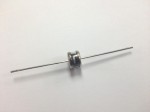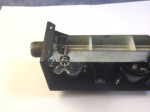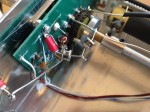Introduction and Tube Radios
Electromagnetic Pulse (EMP) is a serious national threat with growing public awareness. A high-altitude atomic/nuclear explosion sends electrons plowing through the earth’s magnetic field lines and thus generates powerful radio waves that impact the earth below the explosion within a radius of many hundreds to thousands of miles.
The peak field strength is immense, on the order of 50 kilovolts per meter, and covers a very broad frequency spectrum, from very low frequencies, past 100 MHz; but the first wave (named E1) is evanescent, over in a mere microsecond or so. There are additional, slower incident waves– E2 and E3, but these are more of a powerline problem and are not addressed in this article. (I will write on this aspect in a later article.)

Installing this versatile protection device requires only a small amount of wiring/soldering. Figure 2 shows these surge arrestors applied to the center conductor of a popular SWR measurement device. The SWR meter would then be connected to the transmitter side of the shorting antenna switch described above.
The survival problem is the instantaneous destruction (by overvoltage) of transistors, diodes, integrated circuits, FETs, and microprocessors by the immense voltages. Millions of volts and thousands of amperes may flow on ordinary shortwave or Ham radio antennas and feedlines from the E1 wave, for an instant. Handheld VHF/UHF walkie-talkies with antennas only a few inches long won’t be hit with nearly the same level of damaging power that will assault high-frequency (HF) rigs with scores of feet of antennas and feedlines. This article concerns those vulnerable high frequency stations with antennas more than two feet long. Of course, these are the very stations useful for getting interstate, national, and international news and messages flowing.
What about Faraday cages? To protect against E1 EMP, many plan to simply store vulnerable equipment inside an effective Faraday shield– a good quality metal trash can with a tight-fitting lid is suggested, possibly with aluminized tape covering gaps in the lid seal. “Nested” Faraday shields, such as wrapping aluminum foil around the sensitive radio and placing it within a cardboard box inside the trashcan, are also often suggested.

The inadequacy of the Faraday solution is twofold:
- It cannot protect equipment that is in use at the time of the attack, and
- It basically means you don’t dare use your surviving equipment, possibly for years after the initial attack. What if the enemy fires a second or third salvo? One would reasonably worry. What good is equipment that remains vulnerable and may be destroyed if put to use?
There is, therefore, a significant need to have a level of protection available for up-and-running, connected communications equipment, particularly high frequency Ham radio equipment, while possibly also storing spares.
The good news is that, using simple commercially-available surge devices, this article will explain how a reasonable protection strategy can be implemented at a cost in the range of $20! Part One of this article will handle the protection of vacuum-tube type radios, and Part Two will tackle the somewhat more difficult situation of transistorized HF radios (including CB). One of the great advantages of Ham radio is that the licensed users are allowed to build and modify their own stations, and this is one situation where that really pays off.
E1 EMP has characteristics of both extremely high power electromagnetic (radio) interference as well as a very nearby or direct lightning strike. (Lightning also generates enormous radio waves and is a primary cause of background noise on HF frequencies.) Hardening techniques therefore are a combination of shielding and hefty over-voltage circuit protection devices. A side benefit will be an increased level of protection against nearby lightning strikes.

They should be installed on the side of the circuitry that has the 50-ohm impedance (closest to the transmitter, not the antenna side), rather than the possibly high-impedance antenna side, where normal voltages may be much higher.
For those not ready to modify such equipment, Bodson described a simple technique of adding these gas-discharge surge arrestors to the transmission line by using a common “UHF – T” coax connector, and his article gives good instructions for doing so. [2]
This level of protection was adequate in Bodson’s tests to successfully protect vacuum-tube based Ham radio equipment (receivers and transmitters) from simulated E1 EMP-induced voltages. In Part Two, I will discuss the somewhat more difficult task of protecting transistorized/computerized equipment, including external additions to CB transceivers and shortwave receivers.
Solutions for Connected Tube-Type Equipment
There is no sense in tempting fate. When the equipment is not in use, a shorting antenna switch near to the entry of the transmission feedline to the residence can be utilized to conveniently disconnect the equipment from the antenna and further to automatically short out the antenna transmission line. An example of such a switch (there are many) is the OPEK Model CX-201 two-output coaxial switch.[3] When the antenna is de-selected, this switch mechanically grounds the feedline from that antenna, which would knock down the EMP E1 reaching your equipment by many orders of magnitude (manufacturer claims 50dB).
Secondly, simply using coaxial cable as part of the feedline system provides a small amount of protection, as it will arc over with a few kilovolts (depending on the type of cable utilized), somewhat limiting the voltage. (It might be wise to keep some spare coax cable in your Faraday storage compartment.)
Voltage clamp devices are the next (and possibly most important) protection to employ. How does one choose the clamp voltage level? If you are going to transmit, you must ensure that your protection system will not short out your own transmissions (potentially damaging your transmitter)! The transmitter’s output RF voltage is dependent on the standing wave ratio (lower SWR means lower voltage), the feedline impedance (for coax, usually 50 or 75 ohms), and transmitter power. For reference, a 100-watt transmitter output with a 50-ohm transmission line and a well-matched antenna with a 1.5:1 SWR will generate about 110 volts of RF AC in its feedline while transmitting. Obviously, a protection system that shorted out any voltage over 100 volts won’t work well in this instance. The clamping voltage needs to be higher, particularly if you may have worse SWR or a linear amplifier.
A very simple solution that accommodates and reasonably protects most higher-power vacuum tube-based, Ham radio stations, and which indeed performed very well in Bodson’s tests, was to take two 350-volt small gas-discharge surge arrestors (BI-A350; see Figure 1; specification sheet Ref.[4]), wire them in series, and then connect the resulting package between the center wire of the coax transmission line and the shield, with as short a wire length as practical. These gas discharge tubes can carry surge currents from 5-20 thousand amperes. (The device lifetime is shorter with higher current surges.) They are under $4 each from multiple suppliers.[5] With two in series, the breakdown voltage will be in the neighborhood of 700 volts.
References
[1]Bodson, D. Electromagnetic Pulse and the Radio Amateur, Part 3, accessed at: http://www.arrl.org/files/file/Technology/tis/info/pdf/108638.pdf
[2]Bodson D. Electromagnetic Pulse and the Radio Amateur, Part 4, accessed at: http://www.arrl.org/files/file/Technology/tis/info/pdf/118630.pdf
[3]OPEK 2-way coax antenna switch available through American Radio Supply.
[4]http://pdf.datasheetarchive.com/indexerfiles/Scans-057/DSA2IH004905.pdf
[5]BI-A350 available at http://www.digipart.com/part/BI-A350, and alternate 350-volt gas discharge tube voltage clamp devices available at digikey.









